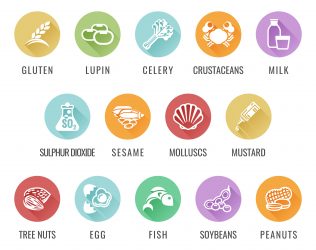The allergen maze
- Like
- Digg
- Del
- Tumblr
- VKontakte
- Buffer
- Love This
- Odnoklassniki
- Meneame
- Blogger
- Amazon
- Yahoo Mail
- Gmail
- AOL
- Newsvine
- HackerNews
- Evernote
- MySpace
- Mail.ru
- Viadeo
- Line
- Comments
- Yummly
- SMS
- Viber
- Telegram
- Subscribe
- Skype
- Facebook Messenger
- Kakao
- LiveJournal
- Yammer
- Edgar
- Fintel
- Mix
- Instapaper
- Copy Link
Posted: 27 August 2020 | Bethan Grylls (New Food) | No comments yet
New Food’s Editor questions whether the current food and drink labelling is adequate and calls for industry to develop single, standardised precautionary allergen labels so allergen sufferers can make safe choices.


How long do you look at a food label for? Perhaps a few seconds, a minute, or maybe you don’t bother at all? For those with food hypersensitivity, reading the label is a necessity and can take around three to five minutes per item.1
Although, I am familiar with reading food labels (suffering with mild food intolerances myself), I cannot imagine the stress a food shop could potentially cause one with severe allergies. I feel it’s important here to take a moment and distinguish the difference between intolerance and allergy.
The former takes place in the digestive system, occurring where an individual is unable to properly breakdown food. It can be extremely uncomfortable, but it is not life threatening. An allergy, on the other hand, involves the immune system, whereby your body mistakes an ingredient, for example egg, as an ‘invader’. Your body reacts by producing antibodies which then travel to the mast cells. These cells release chemicals, including histamine, into the bloodstream which result in the blood vessels expanding, the surrounding skin to become swollen and itchy, and in more extreme cases, a build-up of mucus in the airways which become constricted.2,3


A report from US non-profit, Food Allergy Research and Education (FARE), examined the “complete universe of food allergy consumers”, including their buying habits and the daily challenges they face during a shop. Among the findings, the report identified that those living with allergies find current labels confusing and they “interfere with their daily lives”.
As a result, FARE is advocating for food companies to develop a single, standardised precautionary allergen label (PAL) to help enable allergen sufferers to make informed, safe choices.
Currently, 85 million Americans avoid purchasing produce that include the top nine food allergens. Moreover, around 64 percent buy the same foods every time they shop due to fears of unknown – and potentially unsafe – brands, and as a time-saving exercise.1 Introducing a uniform PAL system would not only empower those with food hypersensitivity, many of whom live in daily fear of an adverse reaction, but it would arguably be a significant opportunity for food manufacturers to demonstrate their commitment to public safety and gain back trust. This is especially important at a time when there is so much uncertainty in the world.
FARE is not alone in this undertaking; in the UK, the Anaphylaxis Campaign is also backing a movement towards standardised PALs after it discovered there were more than 40 ways to express ‘may contain’. Admittedly, this has number has since decreased, but not significantly enough. We need a standardised approach when it comes to PALs and I do hope that in the future one emerges.
References
1. www.foodallergy.org/food-allergy-consumer-journey
2. www.aaaai.org/conditions-and-treatments/library/allergy-library/food-intolerance
3. www.nhs.uk/conditions/mastocytosis
4. https://www.fda.gov/news-events/press-announcements/fda-approves-first-drug-treatment-peanut-allergy-children
Related topics
Allergens, Food Safety, Free From, Ingredients, recalls, Regulation & Legislation, retail, Supermarket, The consumer









